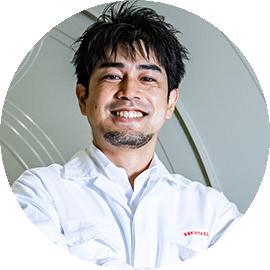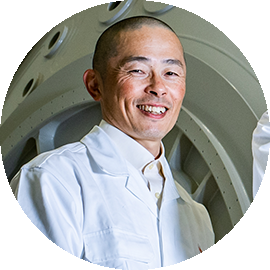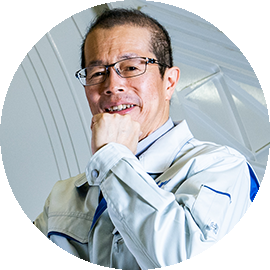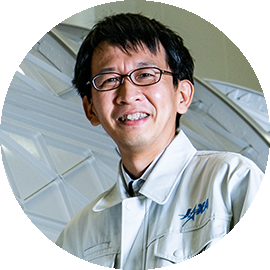Innovation
(Original issue date: January 19, 2023)
Beyond Earth into Space! Honda and JAXA Take on Challenges to Expand the Realm of Human Activity

Index
For the first time in half a century since the Apollo missions, the Artemis program will land people to
the surface of the Moon and conduct a human lunar exploration. Honda has been commissioned by Japan
Aerospace Exploration Agency (JAXA) to research and develop technologies to support a human lunar
exploration in this international project in which Japan is participating.
Honda is expanding its challenges on the ground, in the ocean, in the skies and now into space. Living
on the lunar surface, without an atmosphere, water, or even sun light during the night that lasts up to
two weeks, is no easy task. Honda and JAXA project team members, who have been conducting joint research
since November 2020, provide an insight into this difficult challenges.

Chief Engineer
Innovative Research Excellence, Power Unit & Energy
Honda R&D
Eiji Haryu
Joined Honda R&D in 2004. After working on the research of high differential pressure water electrolysis technology and applying it to develop the Power Creator, Haryu became the development leader in 2019, and assumed responsibility for the entire project involving Honda’s “circulative renewable energy system.”

Assistant Chief Engineer
Innovative Research Excellence, Power Unit & Energy
Honda R&D
Kazunori Fukuma
Joined Honda R&D in 1999. Fukuma has long been engaged in the design of components and systems for fuel cell systems for FCEVs. Fukuma is currently in charge of the joint R&D project with JAXA on circulative renewable energy systems, coordinating technical matters.

Unit Leader
Space Exploration Systems Engineering Unit, International Space Exploration Center
Japan Aerospace Exploration Agency (JAXA)
Naoki Sato
Joined the National Space Development Agency of Japan (now JAXA) in 1988. After working on the development of the International Space Station from 1990 to 2006, Mr. Sato has been a part of the International Space Exploration Program, responsible for overall scenario and mission planning for human lunar exploration.

Senior Research and Development Engineer, Manned Space Technology Center, Manned Space
Technology Division
Japan Aerospace Exploration Agency (JAXA)
Yusuke Sakamoto
Joined JAXA in 2020. While in graduate school, Mr. Sakamoto was involved in research of the engine for the Hayabusa asteroid explorer at JAXA's Sagamihara campus. After graduating, he worked for an airline company for 13 years. Since joining JAXA, Mr. Sakamoto has been working on the development of the circulative renewable energy system at the Manned Space Technology Center.
Pursuit of new areas : taking core Honda technologies into outer space
In November 2020, Honda and JAXA began joint research on a circulative renewable energy system, which is designed to generate and circulate oxygen, hydrogen and electricity from solar energy and water.
But why would Honda, a manufacturer of cars and motorcycles, become involved in the field of space technology?
 Circulative renewable energy system generates electricity, hydrogen and oxygen necessary for
humans and lunar rovers to explore the lunar surface.
Circulative renewable energy system generates electricity, hydrogen and oxygen necessary for
humans and lunar rovers to explore the lunar surface.(C)JAXA/Honda
Haryu
My first visit to JAXA was around November 2018. This visit led to the start of our joint research in
2020, and now we are officially commissioned by JAXA to conduct research and development.
Originally, Honda developed and kept refining its hydrogen-related technologies with the aim to realize
carbon-free vehicles. One such hydrogen-related technology is our high differential pressure water
electrolysis system, which electrolyzes water and produces hydrogen and oxygen. Using electricity
produced by solar power generation for electrolysis, this system can produce hydrogen and oxygen using
only sunlight and water.
Fukuma Our circulative renewable energy system is a combination of the high differential pressure water electrolysis system and a fuel cell system. The fuel cell system produces electricity and water through a chemical reaction between hydrogen and oxygen. Then, the water produced by the fuel cell system is electrolyzed again to produce hydrogen and oxygen, achieving the energy cycle.
 Honda’s circulative renewable energy system uses the high differential pressure water
electrolysis system to electrolyze water to produce hydrogen and oxygen, which are then used by the
fuel call system to generate electricity. The water produced in this process gets circulated for
repeated electrolyzation.
Honda’s circulative renewable energy system uses the high differential pressure water
electrolysis system to electrolyze water to produce hydrogen and oxygen, which are then used by the
fuel call system to generate electricity. The water produced in this process gets circulated for
repeated electrolyzation.
HaryuHonda's high differential pressure water electrolysis system is compact and lightweight because it uniquely does not require a compressor. In around 2018, when we were exploring other uses for this technology, someone mentioned “outer space.” We thought about it and said, “Let’s go talk to JAXA!” At Honda, we had always been thinking about how we can improve the global environment, so the idea of going to outer space didn’t sit well with us initially. But here we are now. Since then, a working group was formed to formally look into the challenges we can take on in the field of space technology, and we decided to launch the project.
Fukuma I was there when the idea came up, and I thought, "This is wild!" At that time, I was only thinking about cars and other things we can do on the ground. The idea was so novel, that I had to take a breath to keep up.
 Fukuma (left) and Haryu (right) were stunned by the fact that they became involved in space
development.
Fukuma (left) and Haryu (right) were stunned by the fact that they became involved in space
development.
Sakamoto By that time, our research and development of the water electrolysis system at JAXA was already ongoing. We believe that the only energy resources available on the Moon are sunlight and water, and we need to supply electricity and hydrogen to manned lunar outposts and rovers. We were attracted to Honda's technology, which can store hydrogen in a compact package.
Sato
In the meantime, JAXA was also researching fuel cells. In space development, "lightweight and compact”
are vital. Our mission is to make fuel cells lightweight. Fuel cells have an energy density that is four
to five times higher than that of currently used lithium-ion batteries, so in other words, they can
deliver the same amount of energy in a much lighter and smaller package.
The cost of transporting something to the lunar surface is about 100 million yen per kilogram. For
example, a lithium-ion battery weighs 4 tons, whereas a fuel cell with equivalent capacity weighs only 1
ton. That changes the transportation cost by tens of billions of yen. That is why fuel cells are more
valuable in space.
 Sato (left) and Sakamoto (right) discuss the need to reduce costs.
Sato (left) and Sakamoto (right) discuss the need to reduce costs.
Sato Since our goal is to turn the Moon into an outpost for our explorations that last over an extended period of time, cost reduction is a major issue not only for space transportation, but also for the space activities to be conducted there. Since there are no resources on the Moon, we have no choice but to circulate and utilize everything. By circulating and generating energy where it is used, we can reduce costs and make our exploration sustainable.
Sakamoto In this sense, Honda's circulative renewable energy system will enable us to downsize the payload capacity and achieve circulative and continuous use of valuable resources. Honda’s system meets both of our key requirements in space. Therefore, Honda and JAXA have started a joint research project to verify its feasibility.
 Smaller,
lighter equipment is required for space transportation using the rocket’s limited payload
capacity.
Smaller,
lighter equipment is required for space transportation using the rocket’s limited payload
capacity.(C)JAXA
Overcoming technical hurdles to go to outer space is the best part of our development
Conditions on the Moon are completely different from those on Earth. The temperature reaches 100°C during the day and -170°C at night. Gravity is one-sixth of that of Earth, and the radiation level is 100 times higher. The lunar surface is an extremely harsh environment. In developing the circulative renewable energy system, the team faced some unexpected difficulties.
 Haryu
explains the conditions that are different from those on Earth cause some difficulties.
Haryu
explains the conditions that are different from those on Earth cause some difficulties.
Haryu The first thing I did as the development leader was to determine which materials could be used. Honda has been developing fuel cells and water electrolysis technology for many years, so we have the basic technology, but we needed to clarify whether our existing technology could be applied in outer space. For example, in pure high-pressure oxygen, many things burn, so materials that we took for granted on Earth cannot be used. Since this is not a field we have been working in, it was difficult at first to find information sources.
Fukuma There is no atmosphere in space. Because of that, temperatures cannot be defined until an object is touched. In terms of numbers and theory I could understand that moon nights are cold or that heat is not transferred, but I could never get a sense of this. The atmosphere does not moderate the temperature. This was an area where I had to make a big change in my thinking from what I knew through automobile development.
 Fukuma
says he had to change his thought process due to the different environment in outer space.
Fukuma
says he had to change his thought process due to the different environment in outer space.
Sakamoto On Earth, heat can be exhausted into the atmosphere, but in space, heat can only be dissipated, so it is difficult to find a way to remove heat from the fuel cells.
Haryu Since there is no atmosphere on the Moon, the system needs to be airtight. This makes it impossible to do things that are common on Earth. This was a challenge and will probably continue to be a challenge in the future. That is the biggest difference.
Fukuma I think that some difficulties and simplicities are reversed from Earth. On Earth, the atmosphere makes some things simple, but there are also areas that need to be considered more carefully because the earth’s atmosphere carries other things (heat or other gasses) away to all over the place. On the other hand, in space, not having an atmosphere makes some areas easy because things disappear forever once released, but some things must be tightly controlled. We realize that the challenges are completely different.
 JAXA’s Sato relates to Honda engineers who are surprised that space is a completely different
story to Earth.
JAXA’s Sato relates to Honda engineers who are surprised that space is a completely different
story to Earth.
Fukuma We also did not anticipate the impact of the noise during rocket launches. With transportation by rocket, in addition to vibration and load, sound is a serious factor. The roar during launch can damage some things. We were taken aback when shown an acoustic impact test.
Sato A rocket’s sound pressure is about 10 times greater than that of an F1 engine. Sure, we can assume the load during the take-off, but it may be hard to imagine the impact of the launch sound.
Haryu I think unexpected issues will continue to come up. While challenges make me nervous as a project manager, they also interest me as an engineer. In a sense, technical challenges are welcome because they give us a competitive edge when we overcome them. The failures we find now are not a problem at all.
 Haryu expresses his joy in facing and overcoming a number of technical hurdles.
Haryu expresses his joy in facing and overcoming a number of technical hurdles.
Fukuma I am also an engineer at heart, so for me, research in new areas is more fun than difficult. It is interesting because my perspectives gets broadened, learning about aspects that I would not have noticed if I was only involved in automobile development.
Haryu There are things that we take for granted on Earth, but technologies and knowledge we amass while dealing with the ultimate inconveniences of space, will definitely be useful for the sustainability of Earth.
Fukuma Fuel cell technology we are developing now is also being further advanced for applications in outer space. Since high durability is required, I believe our fuel cells can also be applied in a variety of industrial uses on Erath. We can expand the use of fuel cells beyond cars. By doing so, I believe we can change society for the better.
Sakamoto At JAXA, we also want to give back to people and contribute to humanity through space development. I believe that we share the same fundamentals and where we want to go.
By 2040, outer space will become a more familiar world for people.
Honda and JAXA's joint research began in November 2020. In October 2022, the project moved into the R&D phase, with different challenges to overcome.
 Sakamoto says, “I feel Honda’s sincere approach toward technology.”
Sakamoto says, “I feel Honda’s sincere approach toward technology.”
Sakamoto Our current goal is to prove the basic technology of the circulative renewable energy system in a laboratory setting. After that, we will raise the maturity level of the technology in an environment closer to outer space.
 Fuel cells under development (photo center) are being tested at JAXA’s Tsukuba Space
Center.
Fuel cells under development (photo center) are being tested at JAXA’s Tsukuba Space
Center.
Haryu
Outer space, which I thought was only in comic books and TV shows, has become my job. It was a strange
feeling at first, but now I too believe it is a natural course of action for people to go into space.
Honda's vision is to expand the realm of human activity, to give “power” to people who do things, and to
help people. Honda has the opportunity to aim for outer space, so it is now my job to implement it, so I
am working to make it a reality, not a pipe dream.
First, we will work toward a lunar surface exploration mission, but we will not stop there. We will look
beyond the future and keep honing our technologies to expand the realm of human activity.
 International space exploration roadmap envisioned by JAXA
International space exploration roadmap envisioned by JAXA (C)JAXA
Sakamoto Since the Apollo era, people have become comfortable with the idea that going to the Moon is possible, so outer space is not a world which is too far away. It’s only about 100km (62 miles) above us!
Haryu Yes. It is just that needing to go straight up makes it a little bit difficult. (laughter)
Sakamoto The problem is cost. In the past, going to outer space was a major national prestige project like the Apollo program, but in recent years, the number of instances of private sector space travel have been increasing. In that sense, I think we are in a great period of time to conduct our joint research.
 Honda and JAXA research continues.
Honda and JAXA research continues.
Sato
The U.S. has already begun reusing rockets. If this becomes the norm and costs come down, it will be
easier for the general public to go to space.
Like Honda, we at JAXA are also looking toward exactly the same direction in terms of expanding the
realm of human activity. From a broader perspective, life originated in the oceans, spread to the earth,
flew into the skies, and now lives in a space station. Going to the Moon is a natural progression. I
think it is an instinct of human beings, or living things.
Haryu I think traveling to outer space will become a common thing for people in the 2030s or 2040s. So we have to start taking on challenges now to prepare for such a time. I believe developing such a mindset and human resources in this field is more important than developing technologies. Honda has a history of taking on new challenges, so I would like to continue our challenges together with JAXA.
- Honda Stories
- Innovation
- Beyond Earth into Space! Honda and JAXA Take on Challenges to Expand the Realm of Human Activity